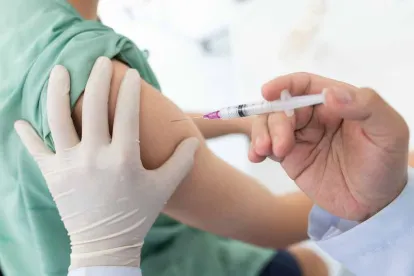On November 5, 2021, OSHA published its new Emergency Temporary Standard (“ETS”) mandating that employers with 100 or more employees require all employees get fully vaccinated against COVID-19 or be required to wear a face covering and undergo weekly testing. Below is a summary of the ETS requirements, as well as the frequently asked questions guidance concurrently issued by OSHA.
Employers and Employees Covered by the ETS
The ETS will apply to employers with a total of 100 or more employees at any time the standard is in effect. Part-time employees and temporary or seasonal employees employed directly by the employer are counted toward this total, but independent contractors and employees of a staffing agency placed in an employer’s workplace are not.
The vaccination and/or testing requirements under the ETS do not apply to employees who:
-
work fully remotely;
-
work exclusively outdoors; or
-
do not report to a workplace where other individuals (i.e. co-workers or customers) are present.
However, such employees should nevertheless be counted toward the 100 employee threshold for employer coverage.
This ETS also does not apply to healthcare workplaces already subject to the Healthcare ETS issued in June 2021, which we previously reported on here, and workplaces subject to the Executive Order applying to federal contractors, previously reported on here and here.
Proof of Vaccination
Under the ETS, employers are required to determine the vaccination status of each employee. The ETS additionally requires employers to maintain a record of each employee’s vaccination status and maintain proof of vaccination for each employee. Employers must maintain a roster of each employee’s vaccination status, including whether they are fully vaccinated, partially vaccinated, not fully vaccinated because of a medical or religious accommodation (discussed further below), or not fully vaccinated because they have not provided acceptable proof of their vaccination status. These records and roster must be maintained in accordance with OSHA’s medical documentation requirements for as long as the ETS remains in effect.
Acceptable proof of vaccination status includes:
-
Record of immunization from a health care provider or pharmacy;
-
A copy of the COVID-19 Vaccination Record Card;
-
A copy of medical records documenting the vaccination;
-
A copy of immunization records from a public health, state, or tribal immunization information system;
-
A copy of any other official documentation that contains the type of vaccine administered, date(s) of administration, and the name of the health care professional(s) or clinic site(s) that administered the vaccine.
If the employee is unable to produce the above forms of proof of vaccination, the employer may accept a signed and dated statement by the employee attesting to: (1) their vaccination status as fully or partially vaccinated; (2) that they have lost or are otherwise unable to produce the above items of proof; (3) the best of their recollection as to the type of vaccine administered, date(s) of administration, and the name of the entity that administered the vaccine; and (4) include language certifying that their vaccine status is accurate, and that false information may be subject to criminal penalties.
If prior to the effective date of the ETS, an employer collected an employee’s vaccination status through a different form of proof and retained documentation of it, the employer is exempt from requiring the above forms of proof for that particular employee.
Mandatory Vaccination Policies
The ETS requires covered employers to establish, implement, and enforce (i) a written mandatory vaccination policy for all employees (including mandatory vaccination for new employees “as soon as practicable”), or (ii) a policy that allows employees to choose either full vaccination or proof of regular testing for COVID-19 and wearing a face covering at nearly all times in the workplace.
Where an employer elects to require mandatory vaccination, it must adopt a policy indicating that all employees are required to be fully vaccinated except those: (1) who are medically contraindicated for a COVID-19 vaccine; (2) for whom medical necessity requires a delay in vaccination; or (3) who are legally entitled to a reasonable accommodation under federal civil rights laws due to a disability or sincerely held religious beliefs, practices, or observances that conflict with the vaccination requirement. If an employee granted reasonable accommodation or otherwise exempted from the vaccination requirement will be entering the workplace, such employees are still subject to the testing and face covering requirements for unvaccinated individuals (discussed further below), unless the testing and/or masking requirements also conflict with disability-related or religious needs, in which case the employer would need to consider the availability of a potential reasonable accommodation in that context as well. The ETS and related FAQs refer employers to the Equal Employment Opportunity Commission’s website for more information about evaluating requests for reasonable accommodations.
Under the ETS, an employee is considered fully vaccinated 2 weeks after completing “primary” vaccination with a COVID-19 vaccine – with at least the minimum recommended interval between doses – that is approved or authorized for emergency use by the FDA, listed for emergency use by the World Health Organization, or in some circumstances administered as part of a clinical trial at a U.S. site. Booster shots and additional doses are not included in the definition of fully vaccinated under the ETS.
COVID-19 Testing and Face Covering Requirements For Employees Who Are Not Fully Vaccinated
Employers who maintain a policy allowing employees to work unvaccinated, or not fully vaccinated, in workplaces where others are present (such as coworkers or customers) must ensure that each employee who is not fully vaccinated meets certain COVID-19 testing and masking requirements.
Regular Testing
Under the ETS, unvaccinated employees reporting to work at least once every 7 days must provide the employer with weekly COVID-19 test results, not to exceed 7 days between tests. Employees who report to work after a period of 7 or more days away from the workplace (for example, after a period of teleworking), must be tested within 7 days prior to returning to the workplace and provide documentation of that test result to the employer upon return to the workplace. If an employee receives a positive COVID-19 test or has been diagnosed with COVID-19 by a licensed healthcare provider, the employer must not require the employee to undergo COVID-19 testing for 90 days following the date of their positive test or diagnosis. Once the employee meets the return to work criteria (outlined in the Notification of Positive COVID-19 Test section below), they may return to the workplace without the testing requirements but must still continue to wear a face covering as described in more detail below.
Acceptable COVID-19 tests under the ETS are those approved or authorized by the FDA, including in an Emergency Use Authorization, administered in accordance with the authorized instructions, and not both self-administered and self-read unless observed by the employer or an authorized telehealth proctor. The ETS requires employers to maintain a record of each test result provided by the employee under this policy or obtained during tests conducted by the employer. If documentation of a COVID-19 test result is not provided as required, employers must keep the employee removed from the workplace until a negative test result is provided.
Notably, the ETS does not require employers to pay for costs associated with COVID-19 testing for employees who are not fully vaccinated, though it acknowledges that employers may be required to cover these costs by other laws, regulations, or collective bargaining agreements. A blog post providing more detail on potential wage and hour implications that may arise from the ETS is available here.
Mandatory Face Covering
The ETS requires employers to ensure each employee who is not fully vaccinated wear a face covering when indoors and when occupying a vehicle with another person for work purposes. Exceptions to this requirement include:
-
When an employee is alone in a room with floor to ceiling walls and a closed door;
-
For a limited time while the employee is eating or drinking at the workplace or for safety or security identification purposes;
-
When an employee is wearing a respirator or facemask (both as defined in the ETS); and
-
Where the employer can show that the use of face coverings is infeasible or creates a greater hazard that would exclude compliance (e.g., when it is important to see the employee’s mouth for reasons related to their job duties or for safety reasons).
The ETS states that employers cannot prevent any employee from voluntarily wearing a face covering or facemask unless the employer can demonstrate wearing such covering would create a hazard of serious injury or death.
Much like testing, the ETS does not require employers to pay for any costs associated with face coverings, though it acknowledges that payment may be required by other laws, regulations, or collective bargaining agreements.
Paid Time for Vaccination
Employers must provide a reasonable amount of time for each employee to acquire their primary vaccination dose(s), up to 4 hours of which per dose must be paid time if the vaccine is being received during working hours. This new paid leave requirement cannot be offset by any other leave that the employee already has accrued, including sick leave or vacation leave.
Employers must also provide “reasonable time” and paid sick leave to recover from side effects experienced following any primary vaccination. While the ETS does not further define “reasonable time” in this context, the FAQs state that if an employer makes available up to 2 days of paid sick leave per vaccination dose for recovery from side effects, the employer would generally be in compliance with this ETS requirement. If an employee is already provided with and has accrued paid sick leave, the employer may require the employee to use such accrued sick leave for recovery from vaccination side effects. If an employer provides employees with multiple types of leave, such as both sick leave and vacation leave, the employer can only require employees to use available sick leave when recovering from vaccination side effects.
Notification of Positive COVID-19 Test
Regardless of employee vaccination status, employers covered under the ETS must require each employee to promptly notify the employer when they receive a positive COVID-19 test or are diagnosed with COVID-19. The employee must be immediately removed from the workplace and kept away from the workplace until the employee: (i) receives a negative COVID-19 nucleic acid amplification test (NAAT) following a positive COVID-19 antigen test result; (ii) meets the return to work criteria in the CDC’s “Isolation Guidance”; or (iii) receives a recommendation to return to work from a licensed healthcare provider.
The ETS does not require employers to provide paid time to any employee for removal from the workplace as a result of a positive COVID-19 test or COVID-19 diagnosis. However, paid time may be required by other laws, regulations, or collective bargaining agreements or other collectively negotiated agreements.
Employee Notice Requirements
Covered employers are required to inform employees, in a language and at a literacy level the employee understands, about the requirements of the ETS and any employer policies or procedures established to implement the ETS. The ETS further requires employers to provide each employee with the CDC’s “Key Things to Know About COVID-19 Vaccines” which describes COVID-19 vaccine efficacy, safety, and the benefits of being vaccinated.
Employees must also be informed of the prohibitions against employers from discharging or discriminating against employees for reporting work-related injuries or illness, exercising their rights under the OSH Act, and the prohibition against retaliating against any employee for filing a workplace safety complaint. Employers are also required to inform each employee of 18 § U.S.C. 1001 and section 17(g) of the OSH Act which provide criminal penalties for knowingly supplying false statements or documentation.
Availability and Reporting of Records
The ETS also includes requirements that employers make certain records promptly available to employees as well as to OSHA. Specifically:
-
If an employee asks for their own individual COVID-19 vaccine documentation or COVID-19 test results, employers must provide such information by the end of the next business day to that particular employee or to anyone having the written authorized consent of that employee. Additionally, upon request by an employee or employee representative, employers must make available by the end of the next day after the request, the aggregate number of fully vaccinated employees at the workplace along with the total number of employees at the workplace.
-
Employers must also provide to OSHA: (i) within 4 business hours of a request, the employer’s written policy required by the ETS, and the aggregate number of fully vaccinated employees at the workplace along with the total number of employees at the workplace; and (ii) by the end of the next business day after a request, all other records and other documents required to be maintained by the ETS.
Effective Dates and Compliance Timeline
The ETS became effective when it was published in the Federal Register on November 5, 2021, and will remain in effect for six months or until OSHA finds a grave danger from the virus no longer exists.
Under the language of the ETS, employers must comply with all requirements by December 6, 2021, except that COVID-19 testing of unvaccinated or non-fully vaccinated employees must begin by January 4, 2022.
Preemption of State & Local Laws
Finally, the ETS makes clear that it preempts states from adopting and enforcing workplace requirements relating to the occupational safety and health issues of vaccination, wearing face coverings, and testing, except under the authority of an OSHA-approved State Plan.







 />i
/>i

